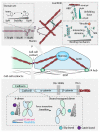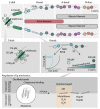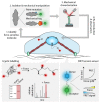The role of single protein elasticity in mechanobiology
- PMID: 37469679
- PMCID: PMC7614781
- DOI: 10.1038/s41578-022-00488-z
The role of single protein elasticity in mechanobiology
Abstract
In addition to biochemical signals and genetic considerations, mechanical forces are rapidly emerging as a master regulator of human physiology. Yet the molecular mechanisms that regulate force-induced functionalities across a wide range of scales, encompassing the cell, tissue or organ levels, are comparatively not so well understood. With the advent, development and refining of single molecule nanomechanical techniques, enabling to exquisitely probe the conformational dynamics of individual proteins under the effect of a calibrated force, we have begun to acquire a comprehensive knowledge on the rich plethora of physicochemical principles that regulate the elasticity of single proteins. Here we review the major advances underpinning our current understanding of how the elasticity of single proteins regulates mechanosensing and mechanotransduction. We discuss the present limitations and future challenges of such a prolific and burgeoning field.
Figures





Similar articles
-
The nanomechanics of individual proteins.Chem Soc Rev. 2020 Oct 7;49(19):6816-6832. doi: 10.1039/d0cs00426j. Epub 2020 Sep 15. Chem Soc Rev. 2020. PMID: 32929436 Review.
-
Molecular stretching modulates mechanosensing pathways.Protein Sci. 2017 Jul;26(7):1337-1351. doi: 10.1002/pro.3188. Epub 2017 Jun 6. Protein Sci. 2017. PMID: 28474792 Free PMC article. Review.
-
Mechanobiology in cardiac mechanics.Biophys Rev. 2021 Aug 27;13(5):583-585. doi: 10.1007/s12551-021-00827-4. eCollection 2021 Oct. Biophys Rev. 2021. PMID: 34765042 Free PMC article.
-
Experimental tools and emerging principles of organellar mechanotransduction.Trends Cell Biol. 2025 Jan 18:S0962-8924(24)00279-4. doi: 10.1016/j.tcb.2024.12.011. Online ahead of print. Trends Cell Biol. 2025. PMID: 39828483 Review.
-
Multiscale Mechanobiology in Brain Physiology and Diseases.Front Cell Dev Biol. 2022 Mar 28;10:823857. doi: 10.3389/fcell.2022.823857. eCollection 2022. Front Cell Dev Biol. 2022. PMID: 35419366 Free PMC article. Review.
Cited by
-
A Hierarchical Mechanotransduction System: From Macro to Micro.Adv Sci (Weinh). 2024 Mar;11(11):e2302327. doi: 10.1002/advs.202302327. Epub 2023 Dec 25. Adv Sci (Weinh). 2024. PMID: 38145330 Free PMC article. Review.
-
Single-molecule magnetic tweezers to unravel protein folding dynamics under force.Biophys Rev. 2025 Feb 8;17(1):25-44. doi: 10.1007/s12551-025-01274-1. eCollection 2025 Feb. Biophys Rev. 2025. PMID: 40060007 Free PMC article. Review.
-
Modeling protein motions through reinforcement learning.Proc Natl Acad Sci U S A. 2024 Dec 17;121(51):e2422180121. doi: 10.1073/pnas.2422180121. Epub 2024 Dec 9. Proc Natl Acad Sci U S A. 2024. PMID: 39652766 Free PMC article. No abstract available.
-
Principles and regulation of mechanosensing.J Cell Sci. 2024 Sep 15;137(18):jcs261338. doi: 10.1242/jcs.261338. Epub 2024 Sep 19. J Cell Sci. 2024. PMID: 39297391 Review.
-
The Role of Mechanotransduction in Contact Inhibition of Locomotion and Proliferation.Int J Mol Sci. 2024 Feb 10;25(4):2135. doi: 10.3390/ijms25042135. Int J Mol Sci. 2024. PMID: 38396812 Free PMC article. Review.
References
Grants and funding
LinkOut - more resources
Full Text Sources
